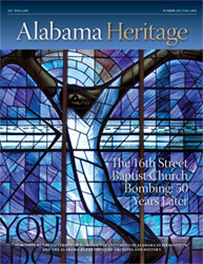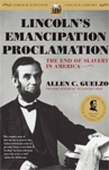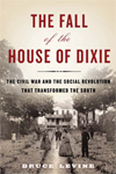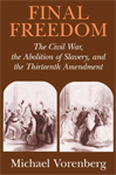|
On the cover: Stained glass window by John Petts, donated in 1965 to the 16th Street Baptist Church by the people of Wales to replace one destroyed in the 1963 bombing. (Library of Congress)
|
FEATURE ABSTRACTS
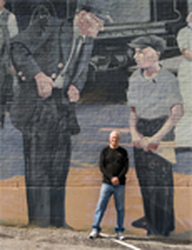 Dothan's mural program was the
Dothan's mural program was the brainchild of former mayor Larry
C. Register, seen here next to a
portrait of his father.
(Robin McDonald)
History on a Grand Scale: The Murals of the Wiregrass
By Scotty E. Kirkland
In the1980s, Dothan received recognition primarily for negative reasons, even being named one of the nation’s “Worst Cities” by Rand McNally. Residents, aware that the town’s rich history transcended the agricultural feats it was most known for, decided to take action, and eventually, their passion gave rise to the Murals of the Wiregrass, a series of nearly twenty outdoor art installations that celebrate the area’s diverse accomplishments, notable cultural and historical moments, and significant residents. Today, these murals have helped put Dothan on the cultural and artistic map—a very different map than the one Rand McNally envisioned several decades ago—and have offered a colorful history lesson of the people and events that shaped this community.
Additional Information
For more information on the history of the region and the Wiregrass Mural Project, see:
* Douglas Fields Bailey, with an Introduction by Alan T. Belsches. Devil Make a Third (Tuscaloosa: University of Alabama Press, 1989).
* William N. Byrd, Jr. “Wiregrass: The Transformation of Southeast Alabama, 1880-1930,” (Ph.D. diss., Auburn University, 2009).
* Scotty E. Kirkland, “Bad, Bad Dothan: The Dothan Riot and Wiregrass Agrarianism”, Alabama Review Vol. 60, No. 3
(July 2007): 163-185.
* Pamela Stepp, The Wiregrass Festival of Murals. (Dothan: Wiregrass Festival of Murals, 2006).
About the Author
Scotty E. Kirkland is curator of history at the History Museum of Mobile. A native of Dothan, Alabama, Kirkland holds a degree in social and political science from Troy University and a master’s degree in American history from the University of South Alabama. His scholarly work has received research and writing awards from the Alabama Department of Archives and History, the Gulf South Historical Association, the Alabama Historical Association, and the University of South Alabama. Kirkland has served as a guest scholar for the Gilder Lehrman Institute of American History and lectures widely on the histories of Dothan and Mobile. He is the book review editor for Alabama Review: A Quarterly Journal of Alabama History. Kirkland is researching a history of Dothan and Houston County, which has been commissioned by the Dothan Landmarks Commission. He lives in Mobile with his wife and son.
By Scotty E. Kirkland
In the1980s, Dothan received recognition primarily for negative reasons, even being named one of the nation’s “Worst Cities” by Rand McNally. Residents, aware that the town’s rich history transcended the agricultural feats it was most known for, decided to take action, and eventually, their passion gave rise to the Murals of the Wiregrass, a series of nearly twenty outdoor art installations that celebrate the area’s diverse accomplishments, notable cultural and historical moments, and significant residents. Today, these murals have helped put Dothan on the cultural and artistic map—a very different map than the one Rand McNally envisioned several decades ago—and have offered a colorful history lesson of the people and events that shaped this community.
Additional Information
For more information on the history of the region and the Wiregrass Mural Project, see:
* Douglas Fields Bailey, with an Introduction by Alan T. Belsches. Devil Make a Third (Tuscaloosa: University of Alabama Press, 1989).
* William N. Byrd, Jr. “Wiregrass: The Transformation of Southeast Alabama, 1880-1930,” (Ph.D. diss., Auburn University, 2009).
* Scotty E. Kirkland, “Bad, Bad Dothan: The Dothan Riot and Wiregrass Agrarianism”, Alabama Review Vol. 60, No. 3
(July 2007): 163-185.
* Pamela Stepp, The Wiregrass Festival of Murals. (Dothan: Wiregrass Festival of Murals, 2006).
About the Author
Scotty E. Kirkland is curator of history at the History Museum of Mobile. A native of Dothan, Alabama, Kirkland holds a degree in social and political science from Troy University and a master’s degree in American history from the University of South Alabama. His scholarly work has received research and writing awards from the Alabama Department of Archives and History, the Gulf South Historical Association, the Alabama Historical Association, and the University of South Alabama. Kirkland has served as a guest scholar for the Gilder Lehrman Institute of American History and lectures widely on the histories of Dothan and Mobile. He is the book review editor for Alabama Review: A Quarterly Journal of Alabama History. Kirkland is researching a history of Dothan and Houston County, which has been commissioned by the Dothan Landmarks Commission. He lives in Mobile with his wife and son.
 Lane Cake is still a favorite,
and many variations
Lane Cake is still a favorite,
and many variationshave evolved over the years.
(Wikimedia Commons)
Alabama Women, Cookbooks, and Identity in the Progressive Era
By Emily Blejwas
As the twentieth century dawned across Alabama, a pair of women embarked on a baking task that likely seemed unremarkable: to create a better cake. In the kitchen of Magnolia Manor, Emma Rylander Lane and Lucy Parish developed what we now know as the Alabama Lane Cake. In the process, they participated in a movement that reflected a dramatic shift in the role of women across the state, one in which new strides in homemaking and culinary science simultaneously elevated the domestic sphere and empowered women to organize for enfranchisement in more public arenas.
Additional Information
For additional information, please see the articles on Lane Cake at the Encyclopedia of Alabama and PBS.
Click here for Emma Rylander Lane's original Lane Cake recipe.
About the Author
Emily Blejwas is the author of forthcoming books on Alabama food history and culture (University of Alabama
Press) and the civil rights movement in Alabama (New South Press). Blejwas holds a master’s degree from Auburn University in rural sociology and economic development and works for the Economic & Community Development Institute at Auburn University. She has helped to develop several cultural initiatives in the state, including Southern Makers, Alabama in the Making, and the Alabama Black Belt Heritage Area, and also serves on the board of the Alabama Folklife Association. She lives in Auburn with her husband and three sons.
Back to Top
By Emily Blejwas
As the twentieth century dawned across Alabama, a pair of women embarked on a baking task that likely seemed unremarkable: to create a better cake. In the kitchen of Magnolia Manor, Emma Rylander Lane and Lucy Parish developed what we now know as the Alabama Lane Cake. In the process, they participated in a movement that reflected a dramatic shift in the role of women across the state, one in which new strides in homemaking and culinary science simultaneously elevated the domestic sphere and empowered women to organize for enfranchisement in more public arenas.
Additional Information
For additional information, please see the articles on Lane Cake at the Encyclopedia of Alabama and PBS.
Click here for Emma Rylander Lane's original Lane Cake recipe.
About the Author
Emily Blejwas is the author of forthcoming books on Alabama food history and culture (University of Alabama
Press) and the civil rights movement in Alabama (New South Press). Blejwas holds a master’s degree from Auburn University in rural sociology and economic development and works for the Economic & Community Development Institute at Auburn University. She has helped to develop several cultural initiatives in the state, including Southern Makers, Alabama in the Making, and the Alabama Black Belt Heritage Area, and also serves on the board of the Alabama Folklife Association. She lives in Auburn with her husband and three sons.
Back to Top
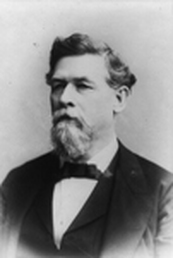 Now largely forgotten,
Now largely forgotten, Philip D. Roddey was considered
a great patriot of the Confederacy.
(Library of Congress)
General Philip D. Roddey: “Defender of North Alabama”
By Zack C. Waters
From modest beginnings, Philip D. Roddey emerged to be one of the Confederacy’s most controversial figures. Through several battles, including Shiloh, Roddey led his men to disrupt the Union efforts in a number of ways, from staking out their encampments and revealing their plans to burning their supplies and pillaging their transportation systems. Working with a number of notable officers, including Nathan Bedford Forrest, Roddey helped secure various parts of the Tennessee Valley for the Confederates. As the war dragged on, though, and as the Confederacy suffered losses, Roddey began to be blamed for some failures—not all of them his. Eventually, accounts of a proposed prisoner exchange evolved into rumors that he tried to surrender, and his image became tarnished in popular memory. Zack Waters explores the true legacy of this Civil War veteran, distinguishing fact from legend and offering a more comprehensive assessment of his career than history has often allowed him.
By Zack C. Waters
From modest beginnings, Philip D. Roddey emerged to be one of the Confederacy’s most controversial figures. Through several battles, including Shiloh, Roddey led his men to disrupt the Union efforts in a number of ways, from staking out their encampments and revealing their plans to burning their supplies and pillaging their transportation systems. Working with a number of notable officers, including Nathan Bedford Forrest, Roddey helped secure various parts of the Tennessee Valley for the Confederates. As the war dragged on, though, and as the Confederacy suffered losses, Roddey began to be blamed for some failures—not all of them his. Eventually, accounts of a proposed prisoner exchange evolved into rumors that he tried to surrender, and his image became tarnished in popular memory. Zack Waters explores the true legacy of this Civil War veteran, distinguishing fact from legend and offering a more comprehensive assessment of his career than history has often allowed him.
Additional Information
Read more about Philip D. Roddey at the Encyclopedia of Alabama.
About the Author
Zack Waters, a retired lawyer, teacher, and college professor, lives with his wife, Vonda, in Rome, Georgia. The University of Alabama Press will publish his latest book, The Kidnapping and Murder of Little “ Skeegie” Cash: J. Edgar Hoover and Florida’s Lindbergh Case (co-written with his brother Robert Waters), early next year. Waters is currently writing a history of Philip D. Roddey and the Civil War in Northwest Alabama.
Back to Top
Read more about Philip D. Roddey at the Encyclopedia of Alabama.
About the Author
Zack Waters, a retired lawyer, teacher, and college professor, lives with his wife, Vonda, in Rome, Georgia. The University of Alabama Press will publish his latest book, The Kidnapping and Murder of Little “ Skeegie” Cash: J. Edgar Hoover and Florida’s Lindbergh Case (co-written with his brother Robert Waters), early next year. Waters is currently writing a history of Philip D. Roddey and the Civil War in Northwest Alabama.
Back to Top
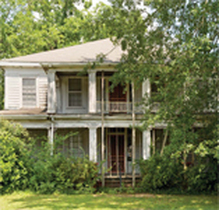 Carrollton Male and Female Academy,
Carrollton Male and Female Academy, founded around 1850
(Robin McDonald)
Places in Peril 2013: Alabama’s Endangered Historic Landmarks
By Melanie Betz Gregory
Once again, Alabama Heritage has partnered with the state’s historical groups to identify a number of significant landmarks in danger of being lost to development, disrepair, or other factors. This year’s list includes hotels, Masonic buildings, homes, school buildings, religious institutions, and even geologic landmarks. One result of the “ Places in Peril” series is that a number of properties over the years have been rescued from destruction or dilapidation, and this year’s properties would benefit from the same intervention.
About the Author
Melanie Betz Gregory joined the staff of the Alabama Historical Commission in the fall of 1989. A native of Illinois, she holds a BA in art history from Western Illinois University and an MA in architectural history and historic preservation from the University of Virginia. Gregory is an architectural historian working with preservation easements and endangered properties.
By Melanie Betz Gregory
Once again, Alabama Heritage has partnered with the state’s historical groups to identify a number of significant landmarks in danger of being lost to development, disrepair, or other factors. This year’s list includes hotels, Masonic buildings, homes, school buildings, religious institutions, and even geologic landmarks. One result of the “ Places in Peril” series is that a number of properties over the years have been rescued from destruction or dilapidation, and this year’s properties would benefit from the same intervention.
About the Author
Melanie Betz Gregory joined the staff of the Alabama Historical Commission in the fall of 1989. A native of Illinois, she holds a BA in art history from Western Illinois University and an MA in architectural history and historic preservation from the University of Virginia. Gregory is an architectural historian working with preservation easements and endangered properties.
To read about more places in peril, click here for our Places in Peril blog.
Department ABSTRACTS
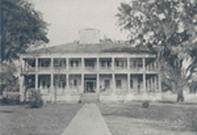 The Howard Hotel on Mobile Bay
The Howard Hotel on Mobile Bay circa 1905
(Alabama Historical Commission)
Southern Architecture and Preservation
Landmark with Many Lives
By Cecile King Striplin
Established as a nineteenth-century getaway, Mobile’s old Howard Hotel offered travelers a bayside respite from the disease and hustle of city life. But upon the death of its owner, it changed hands—and eventually purposes. Cecile Striplin traces the history of this landmark building, from its various identities as a hotel, through its time as a personal residence, to its current use as an administrative building for Bayside Academy. Throughout, she highlights the innovative and interesting developments arising when concerned individuals engage in historic preservation.
About the Author
Cecile King Striplin is a former history instructor and a parent of two Bayside Academy graduates. Robert Gamble, standing editor of the “Southern Architecture and Preservation” department of Alabama Heritage, is senior architectural historian for the Alabama Historical Commission.
Back to Top
Landmark with Many Lives
By Cecile King Striplin
Established as a nineteenth-century getaway, Mobile’s old Howard Hotel offered travelers a bayside respite from the disease and hustle of city life. But upon the death of its owner, it changed hands—and eventually purposes. Cecile Striplin traces the history of this landmark building, from its various identities as a hotel, through its time as a personal residence, to its current use as an administrative building for Bayside Academy. Throughout, she highlights the innovative and interesting developments arising when concerned individuals engage in historic preservation.
About the Author
Cecile King Striplin is a former history instructor and a parent of two Bayside Academy graduates. Robert Gamble, standing editor of the “Southern Architecture and Preservation” department of Alabama Heritage, is senior architectural historian for the Alabama Historical Commission.
Back to Top
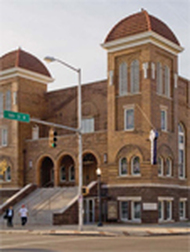 The 16th Street Baptist Church
The 16th Street Baptist Church has a rich history
as Birmingham's first parish
for African Americans.
(Robin McDonald)
Becoming Alabama: Quarter by Quarter
By Joseph W. Pearson, Megan L. Bever, and Matthew L. Downs
Editor’s Note: Alabama Heritage, the Summersell Center for Study of the South, the University of Alabama Department of History, and the Alabama Tourism Department offer this department as a part of the statewide "Becoming Alabama" initiative—a cooperative venture of state organizations to commemorate Alabama’s experiences related to the Creek War, the Civil War, and the civil rights movement. Quarter by quarter we will take you to the corresponding seasons 200, 150, and 50 years ago—sometimes describing pivotal events, sometimes describing daily life, but always illuminating a world in flux. We will wait for the ultimate outcomes as our forebears did—over time. For those joining the story in progress, you can find earlier quarters on our website.
As with each installment of Becoming Alabama, this quarter’s column takes us back to the Creek Wars, Civil War, and civil rights movement, detailing how Andrew Jackson deployed force against the territory’s Native American population, how Tuscaloosa resident Grant Taylor lamented the tedium of fighting in the Civil War, and how the city of Birmingham was stunned and grief-stricken by the bombing of the 16th Street Baptist Church—an act of violence that killed four young girls and galvanized supporters who vowed to bring change to “ Bombingham.”
Additional Information
The 16th Street Baptist Church remains an active parish, but it also holds a small museum related to the bombing. For more information, visit the church’s website.
About the Authors
Joseph W. Pearson is a PhD student in the department of history at the University of Alabama. His research interests include the nineteenth-century South, antebellum politics, and political culture.
Megan L. Bever is currently a doctoral student in the department of history at the University of Alabama. Her research interests include the nineteenth-century South and the Civil War in American culture.
Matthew L. Downs (PhD, Alabama) is an assistant professor of history at the University of Mobile. His dissertation focused on the federal government’s role in the economic development of the Tennessee Valley.
Back to Top
By Joseph W. Pearson, Megan L. Bever, and Matthew L. Downs
Editor’s Note: Alabama Heritage, the Summersell Center for Study of the South, the University of Alabama Department of History, and the Alabama Tourism Department offer this department as a part of the statewide "Becoming Alabama" initiative—a cooperative venture of state organizations to commemorate Alabama’s experiences related to the Creek War, the Civil War, and the civil rights movement. Quarter by quarter we will take you to the corresponding seasons 200, 150, and 50 years ago—sometimes describing pivotal events, sometimes describing daily life, but always illuminating a world in flux. We will wait for the ultimate outcomes as our forebears did—over time. For those joining the story in progress, you can find earlier quarters on our website.
As with each installment of Becoming Alabama, this quarter’s column takes us back to the Creek Wars, Civil War, and civil rights movement, detailing how Andrew Jackson deployed force against the territory’s Native American population, how Tuscaloosa resident Grant Taylor lamented the tedium of fighting in the Civil War, and how the city of Birmingham was stunned and grief-stricken by the bombing of the 16th Street Baptist Church—an act of violence that killed four young girls and galvanized supporters who vowed to bring change to “ Bombingham.”
Additional Information
The 16th Street Baptist Church remains an active parish, but it also holds a small museum related to the bombing. For more information, visit the church’s website.
About the Authors
Joseph W. Pearson is a PhD student in the department of history at the University of Alabama. His research interests include the nineteenth-century South, antebellum politics, and political culture.
Megan L. Bever is currently a doctoral student in the department of history at the University of Alabama. Her research interests include the nineteenth-century South and the Civil War in American culture.
Matthew L. Downs (PhD, Alabama) is an assistant professor of history at the University of Mobile. His dissertation focused on the federal government’s role in the economic development of the Tennessee Valley.
Back to Top
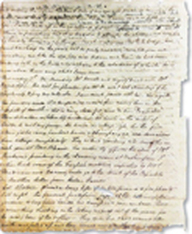 Sarah Gayle's diary details life
Sarah Gayle's diary details life on the Old Southwest frontier.
(W.S. Hoole Special Collections Library,
University of Alabama)
Alabama Treasures
The Journal of Sarah Haynsworth Gayle, 1827–1835
By Sarah Woolfolk Wiggins
First-hand accounts of Alabama life abound for some historical periods, but the Sarah Haynsworth Gayle journal remains singular, as it covers a time period in which the experience of Alabama women is otherwise largely unrepresented. Gayle’s life proved typical, filled with domestic duties to care for her husband, often absent for work, and their many children. And yet, that quotidian nature renders it valuable, as it presents a portrait of everyday life as many Alabamians experienced it. Gayle also refused to mince words, and her lively opinions offer entertainment and illuminating insight on her society and its people. Her journal was so revealing that descendants attempted to conceal portions by defacing pages and excising portions of text. In this piece, Sarah Wiggins describes how the defaced, disintegrating, fragments of the journal were restored and reassembled, in preparation for publication this fall as The Journal of Sarah Haynsworth Gayle, 1827–1835: A Substitute for Social Intercourse (University of Alabama Press).
About the Author
Sarah Woolfolk Wiggins is a professor emerita of history at the University of Alabama and a past president of the Alabama Historical Association. She was the editor of the Alabama Review for twenty years. She is the author or editor of several books from the University of Alabama Press, including: The Scalawag in Alabama Politics, 1865–1881 (1977); From Civil War to Civil Rights—Alabama 1860–1960: An Anthology from “ The Alabama Review” (1987); The Journals of Josiah Gorgas, 1857–1878 (1995); and Love and Duty: Amelia and Josiah Gorgas and Their Family (2005).
Back to Top
The Journal of Sarah Haynsworth Gayle, 1827–1835
By Sarah Woolfolk Wiggins
First-hand accounts of Alabama life abound for some historical periods, but the Sarah Haynsworth Gayle journal remains singular, as it covers a time period in which the experience of Alabama women is otherwise largely unrepresented. Gayle’s life proved typical, filled with domestic duties to care for her husband, often absent for work, and their many children. And yet, that quotidian nature renders it valuable, as it presents a portrait of everyday life as many Alabamians experienced it. Gayle also refused to mince words, and her lively opinions offer entertainment and illuminating insight on her society and its people. Her journal was so revealing that descendants attempted to conceal portions by defacing pages and excising portions of text. In this piece, Sarah Wiggins describes how the defaced, disintegrating, fragments of the journal were restored and reassembled, in preparation for publication this fall as The Journal of Sarah Haynsworth Gayle, 1827–1835: A Substitute for Social Intercourse (University of Alabama Press).
About the Author
Sarah Woolfolk Wiggins is a professor emerita of history at the University of Alabama and a past president of the Alabama Historical Association. She was the editor of the Alabama Review for twenty years. She is the author or editor of several books from the University of Alabama Press, including: The Scalawag in Alabama Politics, 1865–1881 (1977); From Civil War to Civil Rights—Alabama 1860–1960: An Anthology from “ The Alabama Review” (1987); The Journals of Josiah Gorgas, 1857–1878 (1995); and Love and Duty: Amelia and Josiah Gorgas and Their Family (2005).
Back to Top
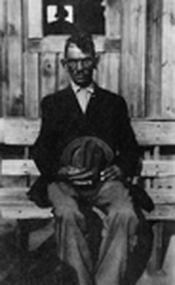 Chief Fred Walker
Chief Fred Walker of the Poarch Creek band
allowed the Episcopal church's mission
(Birmingham Public Library)
Southern Religion
A Visionary Outreach: The Episcopal Church’s Mission to the Poarch Creek Indians
By J. Barry Vaughn
Although the Poarch Band of the Creek Indian Tribe has a vibrant Alabama presence today, its future was not always so secure. In the Great Depression era, Episcopal Bishop George McDowell took a special interest in the Poarch community, sending church officials to reach out to and work with the Native Americans. Although initially wary, the groups soon developed warm and lengthy relationships that continue today.
About the Author
J. Barry Vaughn, an Alabama native, has served Episcopal churches in Alabama, California, and Pennsylvania, and he is presently rector of Christ Church Episcopal in Las Vegas, Nevada. The University of Alabama Press will publish his book, Bishops, Bourbons, and Big Mules: A History of the Episcopal Church in Alabama, later this year. He is grateful to Rev. S. Albert Kennington of Fairhope, Alabama, and the late Lee Martin of Atmore, Alabama, for their assistance in researching and writing this article. Joshua D. Rothman, standing editor of the “Southern Religion” department of Alabama Heritage, is professor of history at the University of Alabama and director of the university’s Frances S. Summersell Center for the Study of the South, which sponsors this department.
Back to Top
A Visionary Outreach: The Episcopal Church’s Mission to the Poarch Creek Indians
By J. Barry Vaughn
Although the Poarch Band of the Creek Indian Tribe has a vibrant Alabama presence today, its future was not always so secure. In the Great Depression era, Episcopal Bishop George McDowell took a special interest in the Poarch community, sending church officials to reach out to and work with the Native Americans. Although initially wary, the groups soon developed warm and lengthy relationships that continue today.
About the Author
J. Barry Vaughn, an Alabama native, has served Episcopal churches in Alabama, California, and Pennsylvania, and he is presently rector of Christ Church Episcopal in Las Vegas, Nevada. The University of Alabama Press will publish his book, Bishops, Bourbons, and Big Mules: A History of the Episcopal Church in Alabama, later this year. He is grateful to Rev. S. Albert Kennington of Fairhope, Alabama, and the late Lee Martin of Atmore, Alabama, for their assistance in researching and writing this article. Joshua D. Rothman, standing editor of the “Southern Religion” department of Alabama Heritage, is professor of history at the University of Alabama and director of the university’s Frances S. Summersell Center for the Study of the South, which sponsors this department.
Back to Top
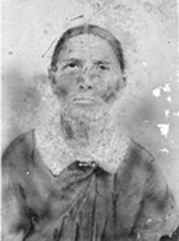 Eliva Nave Gunter,
Eliva Nave Gunter, a prominent Cherokee woman.
(Guntersville Historical Society)
Portraits & Landscapes
The Trail of Tears in Alabama: 175 Years After Cherokee Indian Removal
By Sharon A. Freeman and Larry Smith
The 1830s removal of Native Americans from the southeastern United States, under the leadership of Andrew Jackson, remains well known. However, many of the details of removal—the exact routes taken, the nature of hardships faced, the burial locations of the numerous dead—are largely undocumented. Historians Sharon Freeman and Larry Smith trace the research that’s been done so far, illuminating the various routes taken along the Trail of Tears, and instruct readers how they might be involved in preserving such significant information.
Additional Information
To learn more about the Cherokee Nation, its time in Alabama, and its removal from the state, see this article at the Encyclopedia of Alabama.
About the Authors
Sharon Freeman is an archaeologist and the president of the Alabama Chapter, Trail of Tears Association, and has a special interest in identifying and preserving sites associated with Cherokee removal from Alabama.
Larry Smith holds a bachelor’s degree from Jacksonville State University where he retired in 2001.
Back to Top
The Trail of Tears in Alabama: 175 Years After Cherokee Indian Removal
By Sharon A. Freeman and Larry Smith
The 1830s removal of Native Americans from the southeastern United States, under the leadership of Andrew Jackson, remains well known. However, many of the details of removal—the exact routes taken, the nature of hardships faced, the burial locations of the numerous dead—are largely undocumented. Historians Sharon Freeman and Larry Smith trace the research that’s been done so far, illuminating the various routes taken along the Trail of Tears, and instruct readers how they might be involved in preserving such significant information.
Additional Information
To learn more about the Cherokee Nation, its time in Alabama, and its removal from the state, see this article at the Encyclopedia of Alabama.
About the Authors
Sharon Freeman is an archaeologist and the president of the Alabama Chapter, Trail of Tears Association, and has a special interest in identifying and preserving sites associated with Cherokee removal from Alabama.
Larry Smith holds a bachelor’s degree from Jacksonville State University where he retired in 2001.
Back to Top
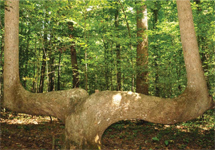 This goalpost-shaped tree
This goalpost-shaped tree marks the site
of four battles.
(W. Mike Howell)
Nature Journal
Marker Trees, Or, Dances with Leaves
By L. J. Davenport
We tend to think of war in terms of its human cost—lives lost, power gained—but conflicts also often leave a profound mark on the land itself. This quarter’s “Nature Journal” explores that phenomenon, looking at the use of “marker” trees to mark both literal battles for territory and the ideological and political struggles waged to preserve the Bankhead National Forest. As such commemorative items, these trees serve both as living organisms and as historical artifacts reminding us of the very precarious nature of their existence.
Additional Information
Many websites are devoted to the documentation of trail or marker trees in our forests. Both photographic and anecdotal evidence are provided for many of the trees—including those that don’t quite pass muster.
Due to space constraints, most of the details (and key people) of the Bankhead battles were left out of this column. Those details can be found in John N. Randolph’s first-hand account, The Battle for Alabama’s Wilderness: Saving the Great Gymnasiums of Nature (University of Alabama Press, 2005).
The author thanks his co-columnist, Stephen Goldfarb, who first suggested writing about trail and marker trees.
About the Author
Larry Davenport is a professor of biology at Samford University, Birmingham.
Back to Top
Marker Trees, Or, Dances with Leaves
By L. J. Davenport
We tend to think of war in terms of its human cost—lives lost, power gained—but conflicts also often leave a profound mark on the land itself. This quarter’s “Nature Journal” explores that phenomenon, looking at the use of “marker” trees to mark both literal battles for territory and the ideological and political struggles waged to preserve the Bankhead National Forest. As such commemorative items, these trees serve both as living organisms and as historical artifacts reminding us of the very precarious nature of their existence.
Additional Information
Many websites are devoted to the documentation of trail or marker trees in our forests. Both photographic and anecdotal evidence are provided for many of the trees—including those that don’t quite pass muster.
Due to space constraints, most of the details (and key people) of the Bankhead battles were left out of this column. Those details can be found in John N. Randolph’s first-hand account, The Battle for Alabama’s Wilderness: Saving the Great Gymnasiums of Nature (University of Alabama Press, 2005).
The author thanks his co-columnist, Stephen Goldfarb, who first suggested writing about trail and marker trees.
About the Author
Larry Davenport is a professor of biology at Samford University, Birmingham.
Back to Top
Reading the Southern Past
The End of the Old South
By Stephen Goldfarb
In this quarter’s installment of “Reading the Southern Past,” author Stephen Goldfarb takes a new look at the Civil War era and the massive social changes that swept the nation during that time. His review considers Bruce Levine’s The Fall of the House of Dixie: The Civil War and the Social Revolution That Transformed the South (Random House, 2013), Allen C. Guelzo’s Lincoln’s Emancipation Proclamation: The End of Slavery in America (Simon & Schuster, 2004), and Michael Vorenberg’s Final Freedom: The Civil War, the Abolition of Slavery, and the Thirteenth Amendment (Cambridge University Press, 2001). Each text adds to the emerging picture of the era, and particularly to the passage of the Thirteenth Amendment to the U.S. Constitution.
About the Author
Stephen Goldfarb holds a PhD in the history of science and technology. He retired from a public library in 2003.
Back to Top
The End of the Old South
By Stephen Goldfarb
In this quarter’s installment of “Reading the Southern Past,” author Stephen Goldfarb takes a new look at the Civil War era and the massive social changes that swept the nation during that time. His review considers Bruce Levine’s The Fall of the House of Dixie: The Civil War and the Social Revolution That Transformed the South (Random House, 2013), Allen C. Guelzo’s Lincoln’s Emancipation Proclamation: The End of Slavery in America (Simon & Schuster, 2004), and Michael Vorenberg’s Final Freedom: The Civil War, the Abolition of Slavery, and the Thirteenth Amendment (Cambridge University Press, 2001). Each text adds to the emerging picture of the era, and particularly to the passage of the Thirteenth Amendment to the U.S. Constitution.
About the Author
Stephen Goldfarb holds a PhD in the history of science and technology. He retired from a public library in 2003.
Back to Top
